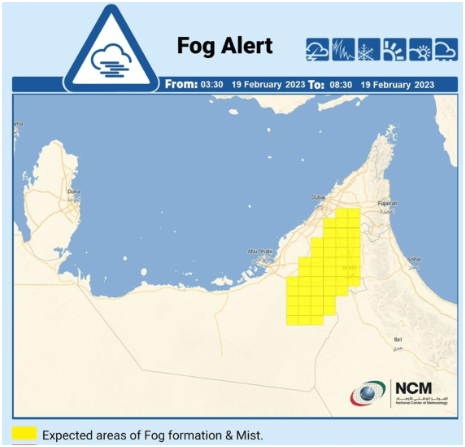UAE Weather Update -Yellow Alert for Fog: Navigating Reduced Visibility
The issuance of a yellow alert for fog indicates the likelihood of reduced visibility on roadways and outdoor areas, posing potential challenges for commuters and travelers. Foggy conditions can significantly impact driving conditions, necessitating caution and adherence to safety protocols. Motorists are advised to:
- Exercise Caution: Reduce speed and maintain a safe distance from other vehicles to account for decreased visibility.
- Use Headlights: Switch on headlights or fog lights to improve visibility and make your vehicle more visible to others on the road.
- Avoid Sudden Maneuvers: Refrain from sudden lane changes or abrupt braking, as these actions can increase the risk of accidents in foggy conditions.
- Monitor Weather Updates: Stay informed about weather forecasts and road advisories to adjust travel plans accordingly and minimize disruptions.
Rising Temperatures: Preparing for Warmer Weather
Simultaneously, temperatures are expected to rise across the UAE as seasonal transitions occur. Residents and visitors can take proactive measures to cope with warmer weather conditions:
- Stay Hydrated: Drink plenty of water throughout the day to stay hydrated and prevent heat-related illnesses.
- Seek Shade: When outdoors, seek shade or shelter from direct sunlight to avoid overheating and sunburn.
- Dress Appropriately: Wear lightweight, breathable clothing and consider using sun protection, such as hats and sunscreen, to shield against harmful UV rays.
- Plan Outdoor Activities: Schedule outdoor activities during cooler times of the day, such as early morning or evening, to minimize exposure to intense heat.
- Stay Informed: Monitor weather forecasts and heat advisories to stay informed about temperature fluctuations and take necessary precautions.
Adapting to Weather Variability in the UAE
As the UAE experiences fluctuations in weather conditions, including foggy spells and rising temperatures, it’s essential for residents and travelers to remain vigilant and adaptable. By heeding weather alerts, exercising caution on the roads, and taking appropriate measures to mitigate the effects of changing weather, individuals can navigate these transitions safely and comfortably. Whether commuting to work, embarking on outdoor adventures, or simply enjoying leisure time, preparedness and awareness are key to thriving amidst the dynamic weather patterns of the UAE.
As the weather patterns shift in the United Arab Emirates (UAE), authorities have issued a yellow alert signaling the onset of foggy conditions in various parts of the country. Concurrently, temperatures are expected to rise, marking a transition in seasonal weather patterns. Let’s delve into the implications of these developments and how residents and travelers can prepare for the changing conditions.
Foggy conditions often disrupt transportation networks, leading to delays in flights, disruptions in maritime operations, and challenges for road traffic. In response, transportation authorities implement measures such as reduced speed limits, enhanced monitoring systems, and public awareness campaigns to mitigate the impact of fog on travel safety and efficiency. Furthermore, ongoing investments in infrastructure, such as the development of advanced fog detection technologies and intelligent transportation systems, aim to enhance the resilience of critical transportation networks to weather-related disruptions.
If the fog is extremely dense and you feel unsafe driving, consider pulling over to a safe location until visibility improves. Turn on your hazard lights to alert other drivers to your presence.
Remember, it’s always better to arrive late than to not arrive at all. Safety should be your top priority when driving in foggy conditions.
Weather variability can also have economic and UAE social implications, particularly for industries sensitive to weather conditions, such as agriculture, tourism, and outdoor recreation. For example, agricultural activities may be affected by fluctuations in temperature and precipitation, requiring adaptive strategies such as diversified cropping systems and water-efficient irrigation practices. Similarly, the tourism sector may experience shifts in visitor preferences and demand patterns in response to changing weather conditions, prompting stakeholders to innovate and diversify tourism offerings to cater to evolving consumer preferences.
Stay Connected: ”Your Source for the Latest News Updates“





